Some of the nation’s leading outdoor educators and youth program leaders came together to tell us just how important it is for kids to spend time outside. The future of the outdoors depends on getting students excited about nature, passionate about conservation, and interested in careers in the outdoor industry. This workshop is jam packed with case studies, discussions, and other great resources to help you get the kids in your community ready to be the next generation of outdoor enthusiasts.
If you purchased tickets to the 2020 conference you’ve been emailed the password to access the videos.
Need help? Contact [email protected] for more info.

Ali Jeney
Science Adventure School, WVU

Andrew Hoover Outdoor Economic Dev. Collaborative, WVU

Ryan Olson
Muddy Sneakers
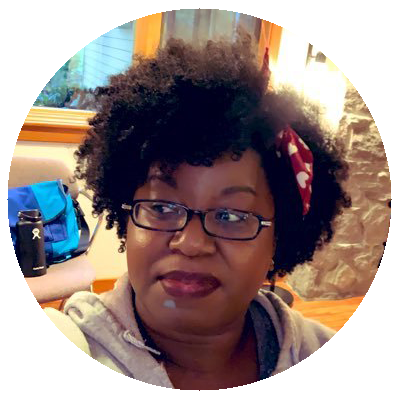
Charissa V Jones
Oregon State University Extension Service
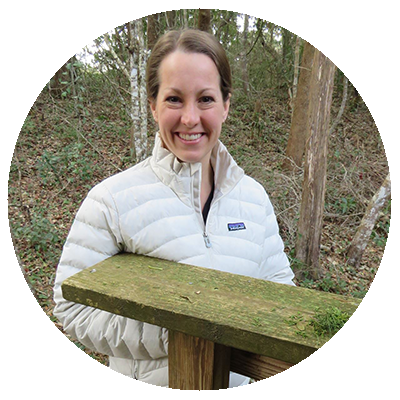
Lauren Pyle
Environmental Educators of North Carolina
“It’s a great equalizer. When you’re in the outdoors, whether you’re recreating or learning, it is the first big step towards everyone being on the same page. It doesn’t matter the equipment you have or the grades you make, if it’s raining we’re all getting wet.”
– Ali Jeney
Not everyone thrives in a classroom. Getting kids outside of the classroom gives them a chance to learn in new environments and in new ways. Some students have trouble focusing in traditional classroom settings, but getting out in nature might just be the key to getting them excited about learning.
Meet them where they are. Every student has different needs, experiences and comfort levels when it comes to outdoor education. Every program will look different – you have to design with your community in mind. Bridge gaps where you can – partnerships can help fund buying gear for students who don’t have it. Having a warm coat can make all the difference on a cold day.
Early interest means better retention. If you’ve never spent time outdoors, it can be intimidating to get started. Introducing kids to nature at a young age can build a lifelong passion for the outdoors.
Design programs with kids in mind. Charissa V. Jones told us how Oregon is making Outdoor School a part of the standard curriculum. They work with advisory committees to make sure they’re designing a program with every child and community in mind. This means providing adaptive gear and other accommodations to make sure every student can enjoy the outdoors equally.
Nature makes science relevant. For a lot of students, learning about science in the classroom just isn’t interesting. Connecting STEM (science, technology, engineering, and math) to nature makes learning fun and engaging – kids can see the real-world applications of topics that once seemed intimidating.

Lise Aageenbrug, Outdoor Industry Association
“None of it works unless all of it works. We really need thriving businesses, thriving people and a thriving planet. We all thrive when we play outside.”
– Lise Aageenbrug
Kids aren’t getting outside like they used to. A recent study showed that 50% of the US population doesn’t get outside to recreate at all, all year long. Of those who do get outside, less than 18% get out at least once a week. Here’s OIA Executive Director Lise Aangeenbrug’s breakdown of some key causes and how to turn the trend around.
What can we do to change that? For a lot of kids, getting outside just isn’t an option. The days of riding your bike until the streetlights came on are gone. Many areas – both urban and rural – lack access to safe outdoor spaces close to home. From a lack of transportation to feeling unwelcome in nature, there are a lot of barriers we need to address if we want young people to spend more time outdoors.
Incorporate fun and joy to build habits. The logic is simple: if you have fun doing something, you’re going to want to do it again. Making your programs fun and joyful will keep kids engaged and make them more willing to go back. Encourage them to get outside with friends and family members. Kids thrive on social connections: they may not remember what they did, but they’ll certainly remember who they were there with.
It takes a village. We can’t limit our outreach to just those working in the outdoor industry. We need to include every member of the community in this work. Small nonprofits don’t have the funding to make big changes on their own, but by including businesses, schools, and individuals we can accomplish more.

Chet Clark
NC Wildlife Resources Commission
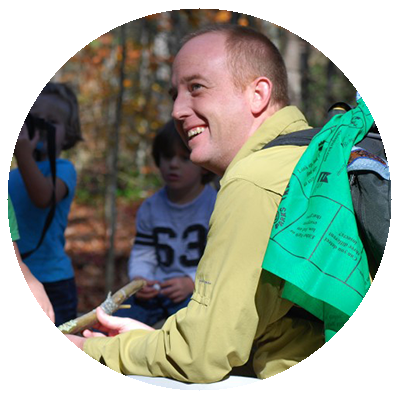
Jason Urroz
Blue Ridge Parkway Foundation

Jonathan Marchal
The North Carolina Arboretum,
University of North Carolina System
“If we don’t get the kids of today outdoors, we risk losing these lands in the future.”
– Jason Urroz
Make nature more welcoming. If you don’t have experience with the outdoors, it might feel like it’s not for you. We need to work on making nature a more welcoming place and prove that it’s for everyone. This happens by working to break down barriers – like lack of transportation or gear – and creating programs that show kids it’s safe and fun to get outdoors.
The pandemic has gotten more people interested in nature. When the world shut down last year, there was an unexpected benefit: people started spending more time outside. Now the challenge is figuring out how to turn what started for many as a casual pandemic hobby into a lifelong passion. For kids, this means getting their parents excited about nature, too, so they can continue having fun outdoor experiences even as they return to in-person school.
Families are willing to travel for nature experiences. The NC Arboretum’s ecoEXPLORE program encourages kids to get outside by turning it into a game. They can earn prizes by submitting photos of nature and visiting “hotspots” across the state. The program took off and they quickly realized families are willing to travel a long way to get to the next trail or hotspot. Not only do the kids benefit from the time outside, it also helps local economies get more business.
Community creates consistent users. Chet Clark talked about the cycle of recruitment, retention and reactivation that people go through when trying out a new activity. The most important phase – retention – requires social support to turn casual users into lifelong nature fanatics. “They’re gaining support somehow – whether it’s through a mentor, a buddy, a family member or digital support … Having them be a part of the community for their activity of choice is very important.” Feeling like a part of a community is the first step to making the outdoors a part of your core identity.

Don Schjeldahl
Don Schjeldahl Group

Lincoln Larson
North Carolina State University

Laura Rodriguez
Youth Outside
“All the research shows that youth outdoor rec is a super important contributor
to a highly functioning and prosperous society.”
– Lincoln Larson
We need to expand the definition of the outdoors. Not everyone has access to traditional outdoor spaces like national and state parks. By expanding our idea of the outdoors to include spaces closer to home — like gardens and city parks – we can make more folks feel welcome and a part of nature.
Everyone has something to bring to the table. “We lead our work with the idea that everyone has knowledge, wisdom and expertise. When we think about young people, Western ideology takes the approach of students as empty vessels … but everyone has something to contribute, whether you’re one or 20,” Laura Rodriguez told us. As educators we should shift our perspective and appreciate what our students can teach us about nature.
Work with, not do to. “Too often we think about what communities need from our perspective, not what they want or what’s already there,”said Lincoln Larson. The idea of co-creation is huge, especially when we’re coming into communities as outsiders. Instead of assuming we have all the answers, it’s important to listen to and work with the community to create programs and spaces that are responsive to their real needs.
Don’t fight technology. We all know that too much screen time is bad for our mental health, while time outside is great for it. As outdoor educators, it’s easy to want to tell students to put their devices away and get outside. But as technology becomes more ingrained in everyday life for kids, it’s not so simple. A study in 2010 found that two-thirds of kids were using technology while outside – and that number has undoubtedly grown in the past eleven years. Instead of fighting against it, we need to get creative and find ways to use technology to enhance outdoor experiences and get more kids outside.

Steve Matous
National Interscholastic Cycling Association

Dr. Gordon Grant
North Carolina Outward Bound School

Bryan Martin
Big City Mountaineers
Providing opportunities + Building key skills. Backpacking trips build important life skills for young people -independence, responsibility, respect for the environment and more. Big City Mountaineers’ mission is to work with young people who otherwise would not get the opportunity to experience nature in this way. Over the past thirty years they’ve spent 47,000 nights under the stars.
Outdoor sports have a huge economic impact. Kids don’t get outside alone, which means that for every young person involved in outdoor activities you can count on parents, grandparents and guardians to join in. For every event held by NICA an average of $180,188 is created in direct economic impact. This isn’t just limited to spending on gear – local hotels, restaurants and shops are benefiting from these events. That’s a win for everyone.
Treat kids with respect. Allow students to lead and make decisions for themselves. Gaining a sense of independence through their time in nature makes the experience even more memorable.
“What I loved as a fourteen year old was I was treated like I had a brain … That’s carried through my entire career. Respect your students. If we try to teach at them or to them, we’ll lose them.
If we ask for their help they’ll step up and show us their best selves.”
– Dr. Grant
Good leaders live their values. According to Steve Matous, “do as I say, not as I do” is bad advice. Kids are going to be watching your every move, so set a good example by truly living out your values. The National Interscholastic Cycling Association lets their core values – fun, respect, inclusivity, equity and community – drive everything they do. “I learned that what I did, not just what I said, was the most important thing in how I worked with students. Leadership is about walking the talk.”

CJ Goulding
The Avarna Group
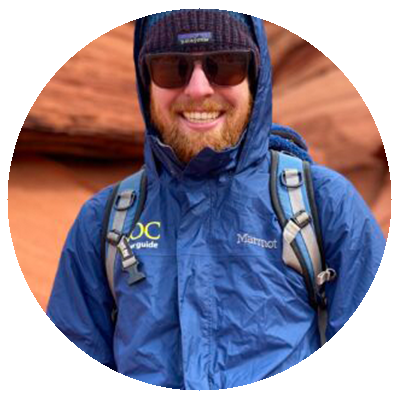
Mickey Timpone
Nantahala Outdoor Center

Elizabeth Walker
Liv Cycling/Giant Bicycles

Anna Rawlins
ENO
“It just felt like home. People were happy, they were passionate. It was honest and genuine… that feeling was not something you get in a lot of jobs or industries.”
– Anna Rawlins
You’re more than a resume. Getting started in any industry can be tough. Liz Walker attributes her success to people seeing her for her potential, not her accomplishments. Being young or new to the outdoor industry can even be a good thing – you can bring a fresh perspective to the table and question those old ways of doing things. “I’m always asking ‘why’. Be willing to question the way things have always been done. Not because they’re bad, but because I think they could be better,” said Anna Rawlins.
It’s not always a straightforward path. Anna Rawlins worked a lot of different jobs – from restaurants to Pilates studios – before she landed at ENO as event marketing manager. She wants to make it easier for others to break into the outdoor industry by making it well known how many career possibilities there are.
There’s more to the outdoor industry than summer jobs. If you’re new to the outdoor world, you may think that it’s all summer camps and temporary guide jobs, but there’s so much more out there. While working a summer job in college, Mickey Timpone saw his older, full-time coworkers and had a realization: this could be a real career.
There’s a place for everyone. You don’t have to be a pro rock climber or Class V paddler to find a home in the outdoor industry. There are all kinds of jobs, from accountants to IT. School guidance counselors need to help connect the dots between a love for the outdoors and the skills students possess, and career centers need help understanding the broader opportunities available within the industry.
“There is life beyond working at summer camp for the season … I didn’t see that there were other opportunities. There are just as many skilled trades within the outdoor industry as there are outside of it.”
– Liz Walker
If you purchased tickets to the 2020 conference you’ve been emailed the password to access the videos.
Need help? Contact [email protected] for more info.
Working Together to Ensure a Vibrant Future for the Outdoor Economy and Our Outdoor Communities.